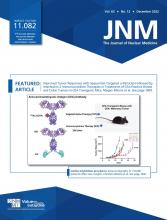Discussions with leaders: Ken Herrmann, MD, MBA, and Michael Hofman, MBBS, FRACP, talk with Declan Murphy, FRACS, FRCS, about his career in genitourinary oncology and widely influential outreach activities in social media.
Page 1783
FAPI PET/CT in nonmalignant diseases: Schmidkonz and colleagues offer a comprehensive review of fibroblast-activation protein inhibitor imaging in nonmalignant diseases to clarify current and potential roles of this class of molecules in nuclear medicine.
Page 1786
FDA approval for theranostic agents: Perera and Morris present an educational overview of regulatory approval for novel radiopharmaceutical agents, including the importance of trial design for agents targeting prostate cancer and regulatory experience with 223Ra and 177Lu-PSMA-617.
Page 1793
Nanoparticle diagnostics and theranostics: Pallares and colleagues provide an overview of nanoparticle-based imaging agents in the clinic and discuss preclinical progress and translational avenues for use in diagnostic and theranostic applications.
Page 1802
Histopathologic validation of 18F-rhPSMA PET: Kroenke and colleagues investigate the accuracy and predictive value of 2 PSMA-targeting radiopharmaceuticals in assessment of lymph node metastases as validated by histopathology.
Page 1809
PSMA PET/CT for therapy assessment: Denis and colleagues use recent European recommendations to compare response assessment to a novel hormonal agent for metastatic castration-resistant prostate cancer between PSMA PET/CT and conventional imaging.
Page 1815
Initial 68Ga-PSMA-11 PET and outcomes: Moradi and colleagues examine the prognostic value of 68Ga-PSMA-11 uptake in the primary lesion and presence of metastatic disease on PET in newly diagnosed prostate cancer before initial therapy.
Page 1822
68Ga-RM2 PET in primary prostate cancer: Duan and colleagues compare preoperative 68Ga-RM2 PET, targeting gastrin-releasing peptide receptors, with postsurgery histopathology in patients with newly diagnosed intermediate- or high-risk prostate cancer.
Page 1829
Setting up a theranostics center: Herrmann and members of a joint European Association of Nuclear Medicine, SNMMI, and International Atomic Energy Agency advisory group provide an enabling guide for radiopharmaceutical stakeholders interested in establishing dedicated theranostics centers.
Page 1836
Repetitive 68Ga-FAPI PET acquisition: Glatting and colleagues report on the diagnostic value of repetitive early PET imaging with 68Ga-FAPI-02, 68Ga-FAPI-46, and 68Ga-FAPI-74 for malignant, inflammatory/reactive, and degenerative lesions and describe implications for future 68Ga-FAPI imaging.
Page 1844
FAP ligand with prolonged tumor uptake: Galbiati and colleagues detail the development and in vivo characterization of BiOncoFAP, a new dimeric fibroblast-activation protein–binding motif with extended tumor residence time and favorable tumor-to-organ ratios.
Page 1852
α-Particle and immunocytokine therapy: Minnix and colleagues investigate tumor reduction and survival outcomes with low-dose targeted α-therapy followed by a 4-dose immunocytokine regimen in mouse breast and colon cancer tumor models.
Page 1859
PET/CT for SiNET staging: Ouvrard and colleagues compare the respective values of 68Ga-DOTATOC and 18F-DOPA PET/CT for initial staging or presurgical work-up of patients with small-intestine neuroendocrine tumors.
Page 1865
First-in-humans tissue factor PET: Loft and colleagues report on PET imaging with an 18F-radiolabeled active-site inhibited version of the tissue factor natural ligand coagulation factor VII and describe its potential as a diagnostic companion for tissue-factor–targeted therapies.
Page 1871
HDL PET and esophageal cancer: Zheng and colleagues use a multimodal imaging approach to assess tumor uptake of exogenously administered, 89Zr-labeled high-density lipoprotein nanoparticles in patients with esophageal cancer.
Page 1880
PET/CT and head and neck cancer staging: Subramaniam and colleagues look at multicenter interobserver agreement and accuracy in 18F-FDG PET/CT imaging for staging of clinical N0 neck in head and neck cancer.
Page 1887
166Ho radioembolization in HCC: Reinders and colleagues establish the toxicity profile of 166Ho radioembolization in patients with measurable, liver-dominant hepatocellular carcinoma and no or very limited curative treatment options.
Page 1891
PET and GI graft-vs.-host disease: Cherk and colleagues explore the diagnostic utility of 18F-FDG PET/CT in noninvasive assessment of patients with clinically suspected acute graft-versus-host disease of the gastrointestinal tract associated with allogeneic hemopoietic stem cell transplantation.
Page 1899
Cardiac amyloidosis in bone scan referrals: Nitsche and colleagues assess cardiac amyloidosis prevalence and outcomes in a large population referred for 99mTc-DPD bone scintigraphy over a decade-long period.
Page 1906
PET imaging of GluN2B-NMDA: Ahmed and colleagues report on in vivo characterization of 18F-OF-NB1 derivatives in nonhuman primates and comment on the potential for imaging of glutamate receptor subtype 2B–containing N-methyl-d-aspartate receptors in several neuropathologies.
Page 1912
Evaluation of 18F-PF-06445974: Wakabayashi and colleagues investigate the properties of the newly developed phosphodiesterase-4–selective radioligand 18F-PF-06445974 in the brains of rodents, monkeys, and humans.
Page 1919
PET MIP prognostic biomarkers in DLBCL: Girum and colleagues explore whether total metabolic tumor volume and tumor dissemination can be replaced by artificial intelligence–generated surrogate features from maximum-intensity projections of whole-body 18F-FDG PET in diffuse large B-cell lymphoma.
Page 1925
Machine learning in sarcoidosis and lymphoma: Lovinfosse and colleagues describe development and validation of radiomics signatures to differentiate sarcoidosis from Hodgkin lymphoma and diffuse large B-cell lymphoma.
Page 1933
PET/CT multiorgan segmentation: Shiyam Sundar and colleagues introduce multiple-organ objective segmentation software that generates subject-specific, multiorgan segmentation using data-centric artificial intelligence principles to facilitate high-throughput systemic investigations via whole-body PET imaging.
Page 1941
Development of fluorinated NP-59: Brooks and colleagues prepare and evaluate an 18F analog of the 131I scintiscanning/SPECT agent NP-59 to serve as a PET agent for functional imaging of the adrenal glands based on cholesterol use.
Page 1949
68Ga-FAPI PET for staging liver fibrosis: Pirasteh and colleagues research the utility of PET in staging liver fibrosis by correlating liver uptake of 68Ga-labeled fibroblast-activation protein inhibitor with histology in a human-sized swine model.
Page 1956
Pediatric PET without sedation: Reichkendler and colleagues report on fast and flexible long-axial-field-of-view 18F-FDG PET/CT acquisition in an unanesthetized 17-mo old with suspected incomplete Kawasaki disease.
Page 1962
- © 2022 by the Society of Nuclear Medicine and Molecular Imaging.







